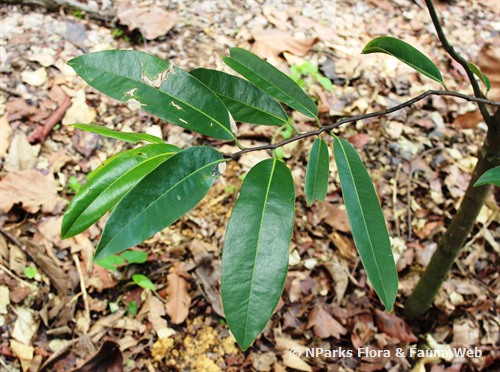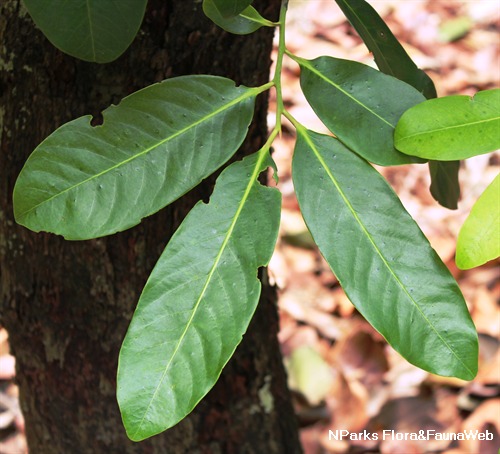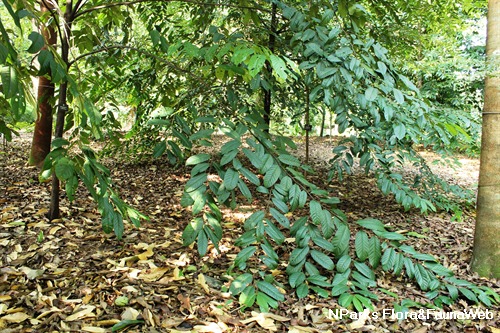_lowres.jpg)
Back
Diospyros latisepala Ridl.
| Family Name: | Ebenaceae |
| Common Name: | Kayu Malam, Siangus, Berumbang Darat, 宽萼柿 |
Diospyros latisepala, also known as Kayu Malam, is a native tree, up to 16 m tall. Named after its black bark and dark coloured wood, it is easily recognized by its leaf-like and persistent fruit calyx clasping at the base of its fleshy fruit.
Name
Classifications and Characteristics
| Plant Division | Angiosperms (Flowering Seed Plants) |
|---|---|
| Plant Growth Form | Tree |
| Lifespan (in Singapore) | Perennial |
| Mode of Nutrition | Autotrophic |
| Plant Shape | Irregular |
| Maximum Height | 16 m |
Biogeography
| Native Distribution | Thailand and Peninsular Malaysia |
|---|---|
| Native Habitat | Terrestrial |
| Preferred Climate Zone | Tropical |
| Local Conservation Status | Native to Singapore (Presumed Nationally Extinct (NEx)) |
Description and Ethnobotany
| Growth Form | It is a tree, about 16 m tall and 0.5 m girth. The bark is black, brittle and finely fissured. |
|---|---|
| Foliage | Leaves are thinly leathery, oblong-elliptic (10 – 25 cm long and 3 – 10 cm wide) and covered with hairs on both sides. The leaf tip is tapering (acuminate) while the leaf base is wedge-shaped (cuneate). Each leaf has about 5 – 8 pairs of secondary veins. The midrib is slightly sunken on the upper surface of the leaf. In contrast, it is prominent and angled on the underside. The petiole is about 0.7 – 1.6 cm long, wrinkled and grooved. |
| Flowers | Flowers occur in a cluster as a cymose inflorescence at the axils of leaves. Inflorescence stalk can reach 1.5 – 6 cm long. Each flower has 4 – 5 sepals which persist and form the fruiting calyx. Petals are united at the base to give a tubular appearance. Male and female flowers occur on different plants (dioecious) and sometimes sporadically hermaphroditic. Male flower has 5 – 7 stamens in one row while female flower has about 8 staminodes and a densely hairy ovary. |
| Fruit | Fruit is fleshy and ellipsoid to ovoid (5 cm long and 4 cm wide). It is hairy when young and gradually becomes smooth (glabrous) as it matures. The calyx is leaf-like, persistent and clasping at the base. It is not distinctly lobed and sometimes irregularly split. Within each fruit, there are 2 – 6 seeds which are covered in a thin layer of pulpy endocarp. |
| Habitat | It is found in rainforest, up to 1000m altitude. |
| Similar | It is similar to Diospyros dictyoneura and can be distinguished by looking at the leaf texture, midrib and stamens. D. latisepala has hairy leaves and midrib that is partly raised above while D. dictyoneura has glabrous leaves and midrib that is fully sunken on the upper surface of the leaf. Also, D. latisepala has 5 – 7 stamens in one row while D. dictyoneura has 20 stamens in two rows. |
| Associated Fauna | Flowers are pollinated by insects. |
| Cultivation | It can be propagated by seed. |
| Etymology | Greek dios, means divine. Greek pyros, means wheat, and together means divine wheat or food, with reference to the edible persimmon fruit. Latin latisepala means having broad sepals. |
Landscaping Features
| Landscape Uses | Reforestation, Parks & Gardens |
|---|
Fauna, Pollination and Dispersal
| Pollination Method(s) | Biotic (Fauna) |
|---|---|
| Seed or Spore Dispersal | Biotic (Fauna) |
Plant Care and Propagation
| Light Preference | Full Sun |
|---|---|
| Water Preference | Moderate Water |
| Plant Growth Rate | Moderate |
| Rootzone Tolerance | Well-Drained Soils |
Foliar
| Foliage Retention | Evergreen |
|---|---|
| Mature Foliage Colour(s) | Green |
| Mature Foliage Texture(s) | Leathery |
| Foliar Type | Simple / Unifoliate |
| Foliar Arrangement Along Stem | Alternate |
| Foliar Attachment to Stem | Petiolate |
| Foliar Shape(s) | |
| Foliar Venation | Pinnate / Net |
| Foliar Margin | Entire |
| Foliar Apex - Tip | Acuminate |
| Foliar Base | Cuneate |
Non - Foliar and Storage
| Trunk Type (Non Palm) | Woody |
|---|---|
| Bark Colour(s) | Black |
| Mature Bark Texture | Fissured |
| Root Type | Underground |
Floral (Angiosperm)
| Flower & Plant Sexuality | Unisexual Flowers , Dioecious |
| Flower Grouping | Cluster / Inflorescence |
|---|
| Flower Location | Axillary |
| Individual Flower Shape | Tubular |
| Inflorescence Type | Cyme |
Fruit, Seed and Spore
| Mature Fruit Texture(s) | Smooth |
|---|---|
| Fruit Classification | Simple Fruit |
| Fruit Type | Fleshy Fruit , Berry |
| Seed Quantity Per Fruit | Few (1-5) |
References
| References | Ng, F.S.P. (1978). Ebenaceae. In: Ng, F.S.P. et al (eds) Tree Flora of Malaya: A Manual for Foresters, vol. 3: Pp. 56 – 94. Kuala Lumpur: Longman Sdn. Bhd. Ridley, H.N. (1923) The Flora of the Malay Peninsula. Vol. 2. Pp. 1 – 672. London: L. Reeve & Co. |
|---|
Image Repository
Others
| Master ID | 34277 |
|---|---|
| Species ID | 8690 |
| Flora Disclaimer | The information in this website has been compiled from reliable sources, such as reference works on medicinal plants. It is not a substitute for medical advice or treatment and NParks does not purport to provide any medical advice. Readers should always consult his/her physician before using or consuming a plant for medicinal purposes. |

_lowres.jpg)
_lowres.jpg)



